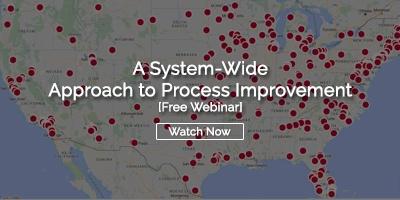Process improvement is a systematic method to eliminate inefficiencies in business operations that cause project delays, employee disengagement, and productivity decline. It involves a continuous cycle of analyzing current processes, identifying areas for enhancement, and implementing incremental changes to better align operations with business goals and reduce waste.
How Does Process Improvement Transform Business Operations?
Process improvement helps organizations meet market demands and accomplish business goals with little waste. Process improvement relies on the idea of comparison; what gets measured improves. It is used widely to bring order to unreliable processes and align all operations with the enterprise goals.
Key Benefits of Process Improvement
-
Reduced operational waste and increased efficiency
-
Enhanced customer satisfaction through streamlined service delivery
-
Improved employee engagement by eliminating frustrating bottlenecks
-
Better resource utilization across the organization
-
Increased competitive advantage through operational excellence
What Are the Primary Goals of Process Improvement?
Effective process improvement implementation requires precise objectives to deliver measurable results. The core goals include:
|
Goal Category |
Specific Objectives |
|
Process Assessment |
Evaluate existing processes, their efficiency, and organizational roles |
|
Alignment Analysis |
Identify misaligned processes and synchronize them with company goals |
|
Value Definition |
Determine how improved results add operational value |
|
Resource Optimization |
Reimagine available resources for effective implementation |

Which Process Improvement Techniques Deliver the Best Results?
Perhaps the best way to describe the meaning of process improvement is to explain some of the tools and techniques used to achieve it. While there is no “right” way to do it, the following techniques are widely used because they have proven effective.
Standard Work
We mentioned earlier that process improvement involves comparing the current state to the desired state. This is difficult if a process is not operated consistently. That’s where Standard work comes in. Standard work is the documented current best practice for any function or task. Every process operator conforms with the Standard until an improvement cycle is completed and a change is implemented. Thus, standard work is the foundation for business process improvement.
The PDSA Improvement Cycle
PDSA stands for Plan, Do, Study, Act. It is a simple yet powerful way to structure improvement:
-
Plan: Analyze current processes, identify goals, and develop improvement hypotheses
-
Do: Implement agreed-upon modifications in a controlled manner
-
Study: Measure results against past performance to validate positive changes
-
Act: Standardize successful improvements and establish ongoing measurement cadence
A3 Problem-Solving
The A3 problem-solving technique works hand in hand with PDSA. On a single sheet of paper, teams document:
|
A3 Section |
Purpose |
|
Background |
This is a description of what needs to be fixed and an argument for solving it. |
|
Current State |
This is a data-centric measurement of the current process results. |
|
Problem Analysis |
This section includes a root-cause analysis that defines the heart of the issue. |
|
Future State |
This area details the project’s specific goals and any countermeasures to the specific issue. |
|
Implementation Plan |
Now, the Who, What, and When of the intended change is addressed. This section includes timing, the team members, and a plan for assessing results over time. |
|
Results |
Once the change is implemented, the team compares the results to the plan and considers the total long-term effect of the project on the organization. |
Rapid Improvement Events
Although process improvement should happen daily, some problems are so severe or opportunities so significant that it makes sense to pull the right people off their regular work to focus on the issue for a three to five-day span. These are called rapid improvement or Kaizen events. A skilled facilitator brings together process operators, subject matter experts, and the “customers” of a process to define the current and ideal states, perform a root cause analysis, consider possible remedies, test proposed improvements, and document the results.
Ideal for:
-
Critical process failures affecting customer satisfaction
-
Major efficiency opportunities with substantial ROI potential
-
Cross-functional issues requiring diverse expertise
-
Time-sensitive competitive advantage situations
The 5 Whys
We mentioned the importance of solving the root cause of a process problem rather than simply fixing the symptoms. The 5 whys is a helpful technique for doing exactly that. You begin with a problem statement and then ask “Why” as many times as necessary (usually around 5) until you get to the real reason for the issue.
Example: Contact Center Abandoned Calls
-
Why are abandoned calls increasing? → Hold times are too long
-
Why are hold times too long? → Not enough agents available during peak hours
-
Why aren't enough agents available? → Scheduling doesn't match call volume patterns
-
Why doesn't scheduling match patterns? → Historical data isn't being used effectively
-
Why isn't historical data being used? → Employee scheduling software lacks analytics capabilities
What Are Real-World Process Improvement Success Stories?
We’re fortunate to be in the position to chat with folks involved in process improvement every day. While every organization is different, here are some simple yet impactful improvements our customers have implemented.
Meeting Schedule Optimization
A hospital system in Texas realized it was increasing staffing costs by holding meetings when staff members weren’t regularly scheduled to work. This resulted in an additional cost of $1,800 a month to pay for the extra hours worked. To eliminate this waste, the team found a way to schedule the meetings during regular work hours.
Skill-Based Routing Implementation
A contact center found that its first call resolution rate was decreasing, leading to reduced customer satisfaction and agent fatigue. To solve this problem, they implemented skill-based routing, allowing customers to use the phone system to select a problem category and be routed directly to an agent with the training needed to solve the problem. This solution allowed them to improve their first call resolution rate by 37%.
Manufacturing Layout Redesign
A shirt manufacturing operation was able to operate with acceptable performance when they processed an average of 5,000 shirts a month, but when they grew to 8,500 shirts, errors increased, and the operation buckled under the pressure. Analysis showed that employees walked an average of 193 feet during the processing of each shirt. The team also discovered that outbound and inbound shipments were sometimes confused since there was only one loading dock. By rearranging the workstations and using visual management, errors were reduced by 75%.
Frequently Asked Questions About Process Improvement
What's the difference between process improvement and process reengineering?
Process improvement focuses on incremental, continuous enhancements to existing processes, while process reengineering involves completely redesigning processes from scratch. Process improvement is typically less disruptive and more sustainable for ongoing operations.
Who should be involved in process improvement efforts?
Effective process improvement requires diverse perspectives including:
- Process operators (front-line employees)
- Subject matter experts
- Process "customers" (internal or external)
- Management stakeholders
- Skilled facilitators for complex initiatives
How do you sustain process improvements long-term?
Sustainability requires:
- Documentation: Update standard work procedures
- Training: Ensure all team members understand new processes
- Monitoring: Establish ongoing measurement systems
- Culture: Foster continuous improvement mindset
- Leadership support: Maintain management commitment to improvement initiatives




Add a Comment